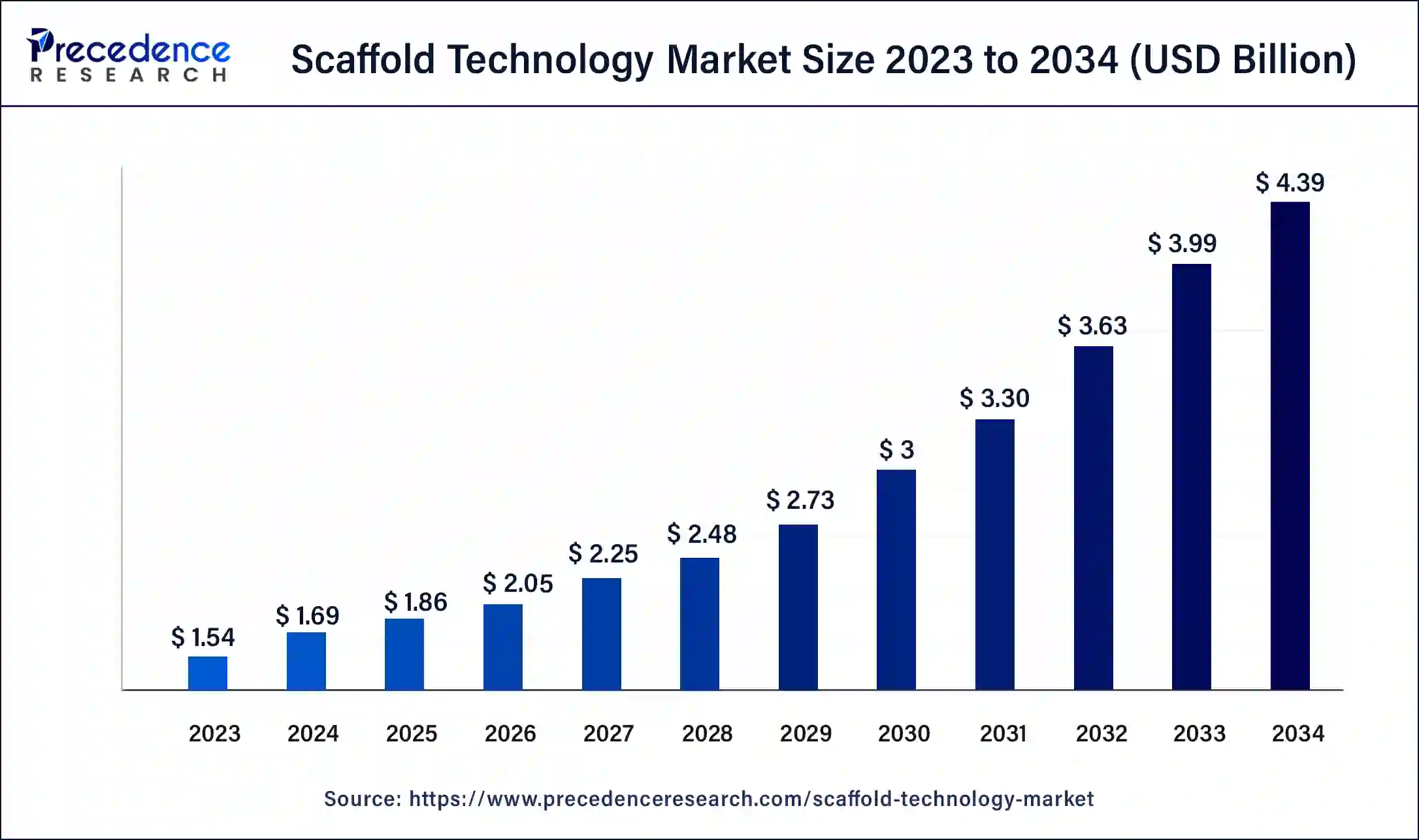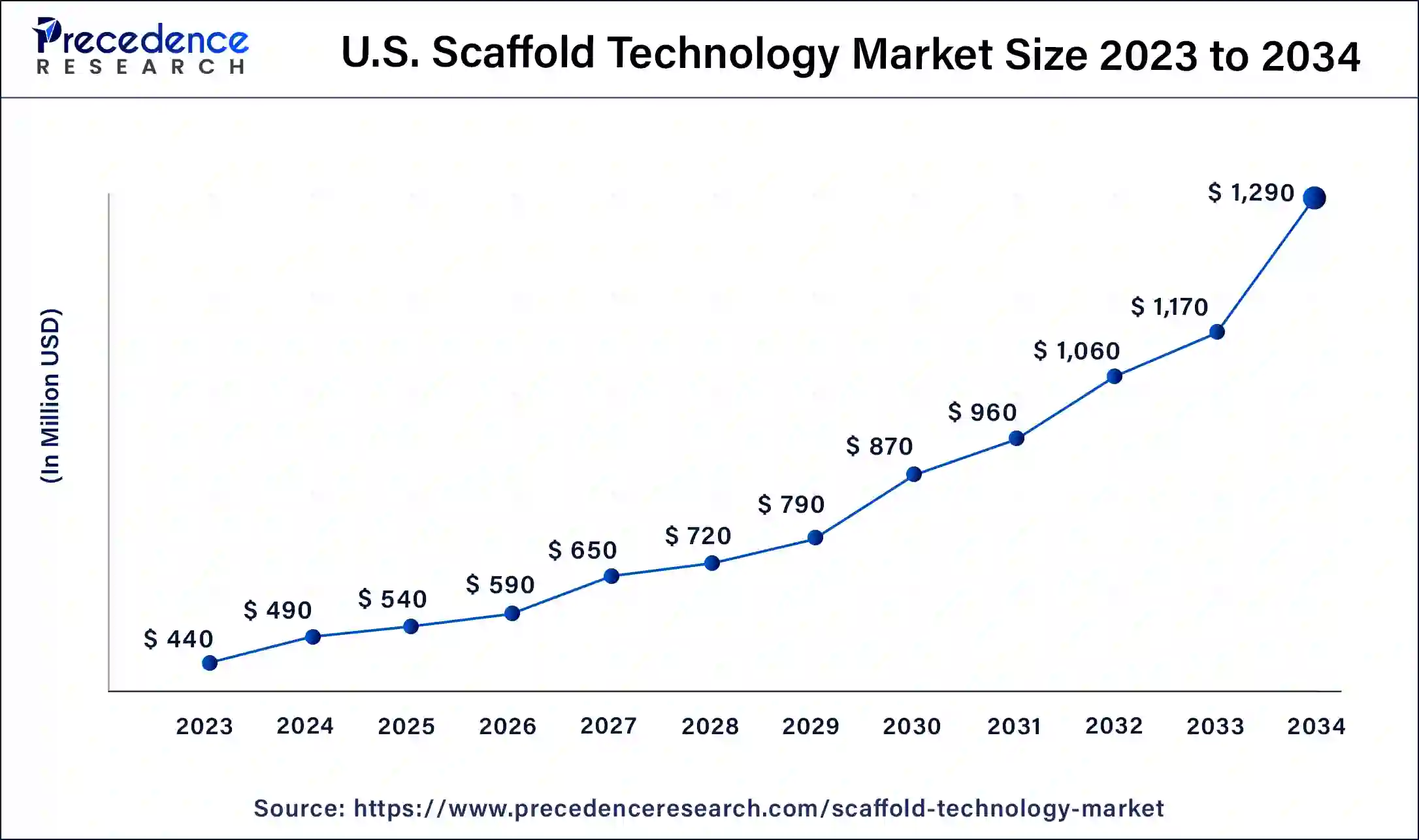What is Scaffold Technology Market Size?
The global scaffold technology market size accounted for USD 1.86 billion in 2025 and is expected to be worth around USD 4.39 billion by 2034, at a CAGR of 10% from 2025 to 2034. Increasing application in the replacement, regeneration, and refurbishment of damaged and unhealthy tissues and organs are driving the growth of global scaffold technology. Moreover, the cumulative R&D venture, rising need for organ transplantation, progression in tissue engineering are driving the growth of market.

Market Highlights
- By, regional, North America has accounted revenue share of over 41% in 2024.
- The Asia-Pacific scaffold technology market is growing faster over the forecast period.
- By type, the hydrogels segment accounted revenue share of around 43.2% in 2024. However, the nanofiber-based scaffolds segment is growing at a CAGR of 9.8% from 2025 to 2034.
- By application, the stem cell therapy, tissue engineering, and regenerative medicine segment held a revenue share of around 66.5% in 2024.
- By disease type, the orthopedics, spine, and musculoskeletal segment has captured a 51% revenue share in 2024.
- By end-use, the biotechnology and pharmaceutical sector segment has accounted revenue share of over 46.9% in 2024.
- The hospitals and diagnostic centers segment is poised to grow at a CAGR of 8.8% from 2025 to 2034.
Market Size and Forecast
- Market Size in 2025: USD 1.86 Billion
- Market Size in 2026: USD 2.05 Billion
- Forecasted Market Size by 2034: USD 4.39 Billion
- CAGR (2025-2034): 10%
- Largest Market in 2024: North America
- Fastest Growing Market: Asia Pacific
How is Innovation Impacting the Scaffold Technology Market?
Thetissue engineeringis multidisciplinary and interdisciplinary sector. It has revealed huge promise in producing living substitutes for harvested organs and tissues for reconstructive and transplantation surgery. Materials and fabrication technologies are significantly imperative for tissue engineering while designing artificial, temporary extracellular matrices or scaffolds which support 3D tissue formation. The vital influence motivating the scaffold technology is the snowballing R&D efforts and the benefit of substituting animal trials with the help of real time biological environment research. This research considers regulatory and ethical issues. With the snowballing application of scaffolds, researchers can better comprehend biological activity of specific treatment on human body. As synthetic scaffold does mimic the biological environment, they are obviously favored over animal trials. Further, technology has progressed the way scaffold are manufactured. Producers are now including the use of 3D printing technology in the scaffold manufacturing procedure.
Market Outlook
- Industry Growth Overview: The market is growing rapidly due to increasing construction, infrastructure, and industrial projects worldwide. Rising demand for safe, efficient, and modular scaffolding solutions, along with technological advancements in materials and design, is driving industry expansion.
- Global Expansion:Global expansion of the market is driven by rising construction and infrastructure projects in Asia-Pacific, North America, and Europe. Companies are investing in advanced, modular scaffolding solutions and forming strategic partnerships to strengthen their international presence.
- Sustainability Trends:Sustainability trends in the scaffold technology market focus on using lightweight, recyclable, and durable materials. Companies are adopting eco-friendly manufacturing processes, modular designs for reusability, and digital planning tools to reduce waste and environmental impact.
Market Scope
| Report Highlights | Details |
| Market Size in 2025 | USD 1.86 Billion |
| Market Size in 2026 | USD 1.69 Billion |
| Market Size by 2034 | USD 4.39 Billion |
| Growth Rate from 2025 to 2034 | CAGR of 10% |
| Base Year | 2024 |
| Forecast Period | 2025 to 2034 |
| Segments Covered | Type, Application, End-User, and Region |
| Regional Scope | North America, Europe, Asia Pacific, Latin America, Middle East & Africa (MEA) |
Segment Insights
Type Insights
Hydrogels segment verified the prime market share more than 40% in the scaffold technology market in 2024. This high share is on account of properties connected to the use of hydrogels, like ease of loading cells and drugs for controlled drug delivery. Since, past few years, hydrogels have attained request as a foremost candidate in tissue engineering and 3D cell cultivation. Continuing technological progressions in the microfabrication of hydrogels are predictable to push growth of this segment.The nanofiber-based scaffolds segment is predicted to eyewitness the rapid growth throughout the prediction period. The nanoscale fibrous structures with interconnecting pores intended by the electrospinning technique ease the development of artificial functional tissues through tissue engineering.
End-User Insights
Among different end-user segments, regenerative medicine, stem cell therapy, and tissue engineering led the global market revenue with a share more than 66.5% in 2024 and is probable to observe the robust growth from 2025 to 2034. High application of scaffolds in aesthetic surgeries, wound healing, soft tissue tumor repair, periodontology, abdominal wall repair, and colorectal surgeries augment the revenue generation in this segment. The requirement for portable and robust tools for drug development and discovery rushes the application of scaffold technology in thedrug discovery sector. The ability of 3D cellular models to imitate the microenvironment for the etiology studies and pathway elucidation has shown reimbursements over traditional processes procedures including mono layer cell cultivation
Application Insights
Orthopedics, musculoskeletal, and spine segment seized the major revenue cut above 51% in 2024 due to upsurge in the occurrence of orthopedic and musculoskeletal complications. Hence, the arrival of novel technologies like electro spun nanofiber scaffolds produced for the engineering of orthopedic tissues flourishes the segment growth. Additionally, neurology segment is likely to inflate at the rapid growth rate throughout the prediction period on account of incessant R&D in regenerative solutions in case of neurological ailments.
Regional Insights
U.S. Scaffold Technology Market Size and Growth 2025 to 2034
The U.S. scaffold technology market size is estimated at USD 540 million in 2025 and is predicted to be worth around USD 1,290 million by 2034, at a CAGR of 10.2% from 2025 to 2034.

U.S. Expands Driven by Construction and Innovation
The U.S. scaffold technology market is expanding due to increasing construction and infrastructure renovation projects across residential, commercial, and industrial sectors. Growing emphasis on worker safety, efficiency, and compliance with OSHA standards is driving demand for advanced and modular scaffolding solutions. Additionally, rising adoption of lightweight, durable materials and innovative scaffold designs, along with investment in large-scale infrastructure initiatives, is further boosting market growth in the country.
The research report incorporates key trends and prospects of scaffold technology products across different geographical regions including North America, Europe, Asia-Pacific, Latin America, and Middle East and Africa.North America is anticipated to control the scaffold technology market on account of well-developed infrastructure, continuing research, and the attendance of key market participants in the region. North America rules the market due to huge number of cancer patients recorded and cumulative death toll on account of cancer. As per WHO, cancer comes 2ndas the chief reason of death worldwide with around 9.6 million deaths in 2018 which influences the market growth. Upsurge in funding by government and regional companies subsidizes the market growth with continuous R&D attempts that aid in the growth of this technology.
Though, the scaffold technology market in Asia Pacific is likely to register the highest growth rate throughout the estimate period, due to the snowballing government focus on increasing research and development in the pharmaceutical sector and the refining health care infrastructure in the region.
China: Surge with Urbanization and Construction Boom
China's scaffold technology market is growing due to rapid urbanization, a booming construction industry, and increasing infrastructure development projects. Rising demand for safer, efficient, and modular scaffolding solutions is driving adoption. Additionally, government investments in smart city initiatives, high-rise buildings, and industrial facilities, along with advancements in lightweight and durable scaffold materials, are further fueling market growth in the country.
Europe Rises with Innovation and Infrastructure
The European market is growing as construction companies increasingly adopt innovative and customizable scaffolding systems to improve efficiency and reduce labor costs. Demand is also fueled by rising infrastructure projects, industrial maintenance, and energy sector developments. Additionally, emphasis on eco-friendly materials, digital integration for project planning, and safety compliance across European countries is driving the adoption of advanced scaffold solutions.
France: Gain Momentum with Safety and Urban Development
France's scaffold technology market is expanding due to increasing investments in urban development, commercial construction, and infrastructure renovation projects. The adoption of modular, lightweight, and safe scaffolding systems is rising to enhance efficiency and reduce on-site risks. Additionally, government regulations emphasizing worker safety, combined with the growing use of technologically advanced scaffolds in industrial maintenance and energy projects, are driving steady market growth in the country.
Top Vendors and their Offerings
- Nanofiber Solutions, Inc.: Offers off-the-shelf nanofiber scaffolds used in tissue engineering and regenerative medicine, including nanofiber plates, custom 3D scaffolds, and well plate inserts for cell culture.
- Avacta Life Sciences Limited: Though better known for its protein scaffold platforms (Affimer) in diagnostics and therapeutics, it lists itself among key players in the scaffold technology market, suggesting its scaffold offerings may extend into tissue/regenerative applications.
- Merck KGaA: Recognised as a major competitor in the scaffold technology market, offering scaffold solutions (hydrogels, polymeric scaffolds, etc.) for tissue engineering, drug discovery, and bio research workflows.
- Tecan Trading AG: Named among key players in scaffold technology (as per market reports) – likely offering scaffold products as part of its life science instrumentation/consumables platform.
- 3D Biomatrix: Also cited in market reports for scaffold technology – providing 3D scaffolds intended for tissue engineering, regenerative medicine, or research applications.
Scaffold Technology Market Companies
- Merck KGaA
- Avacta Life Sciences Limited
- Nanofiber Solutions
- 4titude
- Tecan Trading AG
- REPROCELL Inc.
- Matricel GmbH
- 3D Biomatrix
- Vericel Corporation
Segments Coverd in the Report
By Type
- Hydrogels
- Micropatterned Surface Microplates
- Nanofiber Based Scaffolds
By End-User
- Stem Cell Therapy, Tissue Engineering & Regenerative Medicine
- Drug Discover
- Others
By Application
- Neurology
- Urology
- Orthopedics
- Dental
- Cardiology & Vascular
- Cancer
- Skin & Integumentary
- GI & Gynecology
- Others
By Material
- Bio-inert
- Bioresorbable
- Bioactive
By Region
- North America
- Europe
- Asia Pacific
- Latin America
- Middle East and Africa
For inquiries regarding discounts, bulk purchases, or customization requests, please contact us at sales@precedenceresearch.com
Frequently Asked Questions
Ask For Sample
No cookie-cutter, only authentic analysis – take the 1st step to become a Precedence Research client
 sales@precedenceresearch.com
sales@precedenceresearch.com
 +1 804-441-9344
+1 804-441-9344